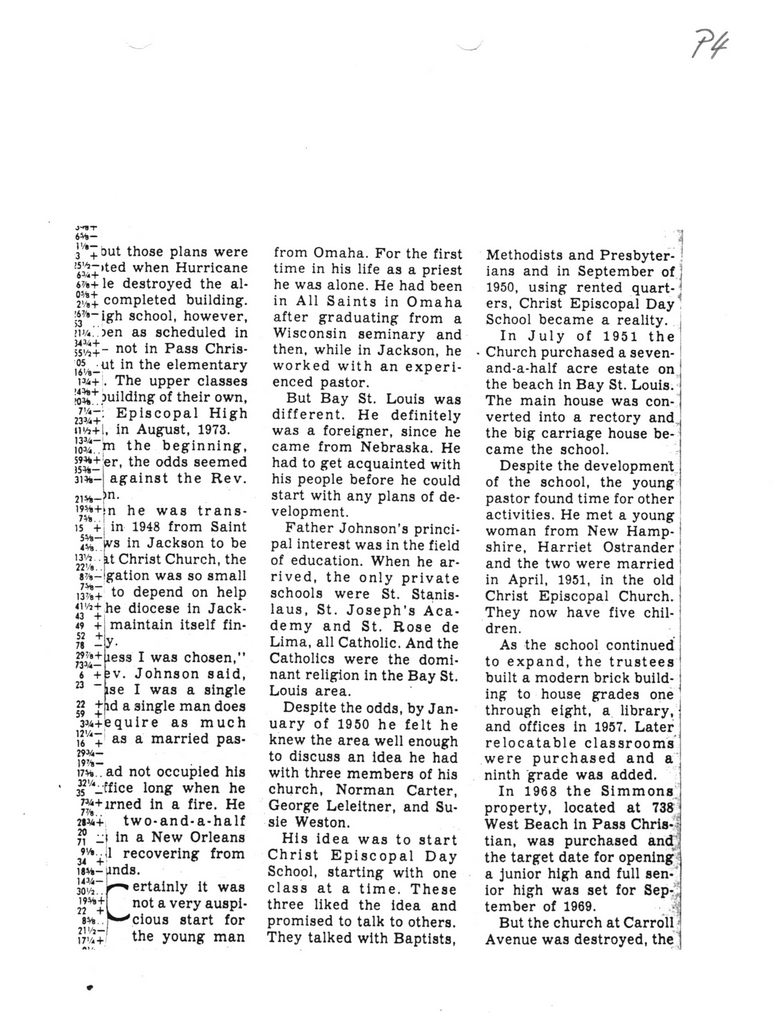This text was obtained via automated optical character recognition.
It has not been edited and may therefore contain several errors.
6*»- 3*+ but those plans were !5£->ted when Hurricane 4?*+ le destroyed the al-vlX completed building. *’*_igh school, however, >iv*. oen as scheduled in sjJSJ- no^ Pass Chris-os._ut in the elementary t£+. The upper classes juilding of their own, 23%+' EPiscoPal High im+l, in August, 1973. !2*"m the beginning, ”*±;er, the odds seemed 3i*- against the Rev. 21**-?n- '’JJ+sn he was trans- 15 +| in 1948 from Saint 5tJ-|vs in Jackson to be jr* ^ Christ Church, the «4'-!gation was so small 131*+ to depend on help JJ'^+he diocese in Jack- 49 + maintain itself fin-52 + v 78 -J-2*5*+ 1VA-6 + 23 - less I was chosen,” ;v. Johnson said, ise I was a single (id a single man does 3«i+equire as much i|V4+ as a married pas-2*%- i7H..ad not occupied his 32'/4_.ffice iong when he ^j+irned in a fire. He 21V+ two-and-a-half “ "I In a New Orleans j^tl recovering from im-finds. ertainly it was 2?*+l not a ver^ ausP*' 14* S^cious start for 21'/i-| I7'4 + the young man from Omaha. For the first time in his life as a priest he was alone. He had been in All Saints in Omaha after graduating from a Wisconsin seminary and then, while in Jackson, he worked with an experienced pastor. But Bay St. Louis was different. He definitely was a foreigner, since he came from Nebraska. He had to get acquainted with his people before he could start with any plans of development. Father Johnson’s principal interest was in the field of education. When he arrived, the only private schools were St. Stanislaus, St. Joseph's Academy and St. Rose de Lima, all Catholic. And the Catholics were the dominant religion in the Bay St. Louis area. Despite the odds, by January of 1950 he felt he knew the area well enough to discuss an idea he had with three members of his church, Norman Carter, George Leleitner, and Susie Weston. His idea was to start Christ Episcopal Day School, starting with one class at a time. These three liked the idea and promised to talk to others. They talked with Baptists, /i Methodists and Presbyter ians and in September of j 1950, using rented quart-' ers, Christ Episcopal Day School became a reality. . In July of 1951 the Church purchased a seven-and-a-half acre estate on J the beach in Bay St. Louis, j The main house was con- | verted into a rectory and , the big carriage house be- J came the school. 1 Despite the development j of the school, the young I pastor found time for other activities. He met a young woman from New Hamp-1 shire, Harriet Ostrander j and the two were married ' in April, 1951, in the old Christ Episcopal Church. 1 They now have five chil- j dren. : As the school continued j to expand, the trustees 1 built a modern brick build- ] ing to house grades one through eight, a library, and offices in 1957. Later relocatable classrooms were purchased and a ninth grade was added. In 1968 the Simmons property, located at 738 West Beach in Pass Chris-'^ tian, was purchased an<£ the target date for opening^ a junior high and full sen-* ior high was set for Sep-* tember of 1969. 3 But the church at Carroll Avenue was destroyed, the

Christ Episcopal Church Rev-Charles-Johnson-(6)